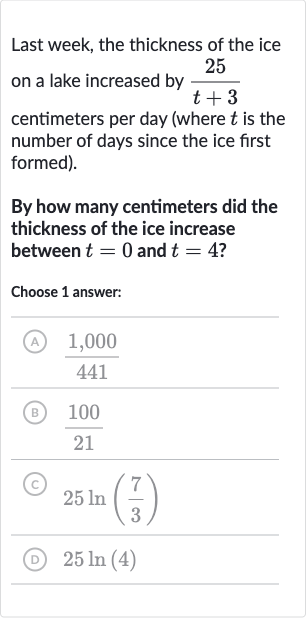Full solution
Q. Last week, the thickness of the ice on a lake increased by centimeters per day (where is the number of days since the ice first formed).By how many centimeters did the thickness of the ice increase between and ?Choose answer:(A) (B) (C) (D)
- Integrate Rate of Increase: To find the total increase in thickness over a period of time, we need to integrate the rate of increase with respect to time from the starting time to the ending time .
- Given Rate Function: The rate of increase in thickness is given by the function centimeters per day. We need to integrate this function from to .
- Calculate Integral: The integral of from to is .
- Apply Logarithm Rule: To integrate , we recognize that the integral of is the natural logarithm of the absolute value of . Therefore, the integral of is times the natural logarithm of the absolute value of .
- Calculate Definite Integral: We calculate the definite integral: from to .
- Evaluate Limits: Plugging in the limits of integration, we get .
- Combine Logarithms: We use the properties of logarithms to combine the terms: .
- Final Result: The final result is .
- Compare with Answer: Comparing the final result with the answer choices, we see that it matches with option (C) .
More problems from Operations with rational exponents
QuestionGet tutor help
QuestionGet tutor help
QuestionGet tutor help
QuestionGet tutor help
QuestionGet tutor help
QuestionGet tutor help

